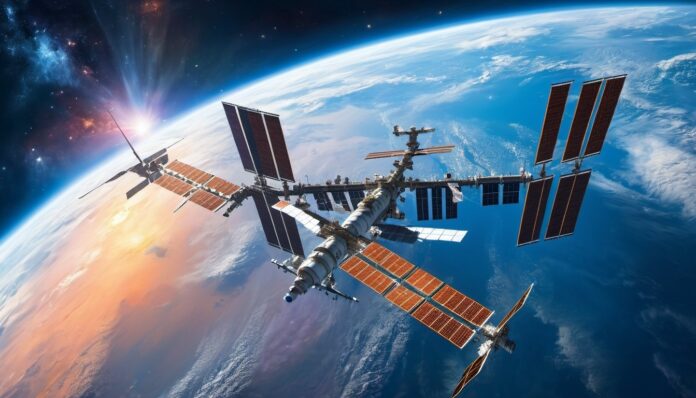The International Space Station (ISS) is a large spacecraft that orbits Earth. It serves as a home where astronauts live and work. The ISS is a joint project involving multiple space agencies: NASA (United States), Roscosmos (Russia), JAXA (Japan), ESA (Europe), and CSA (Canada).
Here are the most interesting facts about the International Space Station (ISS)
Construction: The ISS was assembled in space, starting in 1998, with many modules added over time.
Size: It’s about the size of a football field, making it the largest human-made structure in space.
Orbit: The ISS orbits Earth at an altitude of approximately 400 kilometers (about 250 miles).
Speed: It travels at a speed of about 28,000 kilometers per hour (17,500 miles per hour), completing an orbit around Earth roughly every 90 minutes.
Purpose and Research:
-
- Living and Working Space: The ISS provides living space for a crew of six astronauts who conduct scientific research.
- Research: Experiments conducted on the ISS cover various fields such as biology, physics, astronomy, and meteorology. The microgravity environment allows scientists to study phenomena that can’t be observed on Earth.
- The ISS consists of 14 interconnected modules.
- The ISS is considered the most expensive project in the history of humanity.
- Did you know that astronauts (see interesting facts about astronauts) aboard the station can observe sunrises and sunsets every 45 minutes?
- All energy on the ISS is generated by solar panels.
- The ISS orbits at a high speed at an altitude of 415-420 km.
- In some cases, the ISS has to change its course to avoid collisions with space debris.
- Interestingly, the weight of the ISS is approximately 417 tons.
- The station is equipped with special trainers so that astronauts can perform physical exercises. Otherwise, their muscles could atrophy.
- Curiously, the ISS can be seen from Earth with the naked eye.
- More than $157 billion has already been spent on the construction and operation of the ISS!
- The internal volume of the ISS is approximately 1000 cubic meters.
- Russia has built 5 modules of the station, and the USA has built 7. The other two modules were built by Japan and the EU.
- The ISS is the third brightest object in the night sky, after Venus and the Moon (see interesting facts about the Moon).
- The ISS has been in operation since 1998. According to plans, the station should operate until 2024, although an extension of the operational period until 2030 is not excluded.
- The speed at which the ISS moves in orbit is approximately 27,700 km/h.
- Did you know that the permanent crew of the ISS consists of 6 astronauts?
- There is a “Disk of Immortality” on the station, which contains DNA information of famous people.
- Interestingly, on May 6, 2016, the ISS completed its 100,000th orbit around our planet.
- Both toilets on the station were developed in Russia. It is worth noting that each toilet is equipped with leg restraints and special hip holders.
- The ISS stores “oxygen candles”. After ignition, one such “candle” can provide oxygen for one person for a day.
- The ISS hull partially protects astronauts from solar radiation, but only partially.
- As of today, the ISS has been visited by the largest number of people flying into space (see interesting facts about space).
- Interestingly, not only space but also medical, biological, and physical research is conducted aboard the ISS.
- There is a greenhouse on board the ISS where various greens are successfully grown.
The ISS serves as a symbol of international cooperation in space exploration, bringing together scientists, engineers, and astronauts from various countries to work towards common goals. This collaborative effort showcases the power of humanity’s unity in the pursuit of knowledge and exploration beyond the confines of Earth.
